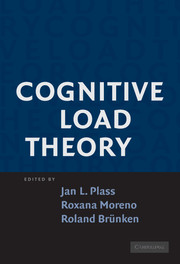Book contents
- Frontmatter
- Contents
- Contributors
- COGNITIVE LOAD THEORY
- Introduction
- PART ONE THEORY
- PART TWO EMPIRICAL EVIDENCE
- 5 Learning from Worked-Out Examples and Problem Solving
- 6 Instructional Control of Cognitive Load in the Design of Complex Learning Environments
- 7 Techniques That Reduce Extraneous Cognitive Load and Manage Intrinsic Cognitive Load during Multimedia Learning
- 8 Techniques That Increase Generative Processing in Multimedia Learning: Open Questions for Cognitive Load Research
- PART THREE DISCUSSION
- Index
- References
7 - Techniques That Reduce Extraneous Cognitive Load and Manage Intrinsic Cognitive Load during Multimedia Learning
Published online by Cambridge University Press: 05 June 2012
- Frontmatter
- Contents
- Contributors
- COGNITIVE LOAD THEORY
- Introduction
- PART ONE THEORY
- PART TWO EMPIRICAL EVIDENCE
- 5 Learning from Worked-Out Examples and Problem Solving
- 6 Instructional Control of Cognitive Load in the Design of Complex Learning Environments
- 7 Techniques That Reduce Extraneous Cognitive Load and Manage Intrinsic Cognitive Load during Multimedia Learning
- 8 Techniques That Increase Generative Processing in Multimedia Learning: Open Questions for Cognitive Load Research
- PART THREE DISCUSSION
- Index
- References
Summary
WHAT IS MULTIMEDIA LEARNING?
Suppose you open an online multimedia encyclopedia and click on the entry for “pumps.” Then, the computer presents a narrated animation describing how a pump works. Alternatively, suppose you are playing an educational science game on your computer in which you fly to a new planet and must design a plant that would survive there. An on-screen character guides you and explains how the characteristics of the roots, stem, and leaves relate to various environmental conditions. Both of these examples – multimedia lessons and agent-based simulation games – are forms of computer-based multimedia learning environments. They are multimedia learning environments because they involve words (e.g., printed or spoken words) and pictures (e.g., animation, video, illustrations, or photos). They are computer-based learning environments because they are presented via computer. Our goal in this chapter is to explore research-based principles for improving the instructional design of computer-based multimedia learning.
We begin with the premise that research on multimedia learning should be theory based, educationally relevant, and scientifically rigorous. By calling for theory-based research, we mean that research on multimedia learning should be grounded in a cognitive theory of multimedia learning. In this chapter, we build on the cognitive theory of multimedia learning (Mayer, 2001, 2005a, 2005b; Mayer & Moreno, 2003), which is adapted from Cognitive Load Theory (CLT) (Paas, Renkl, & Sweller, 2003; Sweller, 1999, 2005). By calling for educationally relevant research, we mean that research on multimedia learning should be concerned with authentic learning situations and materials.
- Type
- Chapter
- Information
- Cognitive Load Theory , pp. 131 - 152Publisher: Cambridge University PressPrint publication year: 2010
References
- 65
- Cited by

